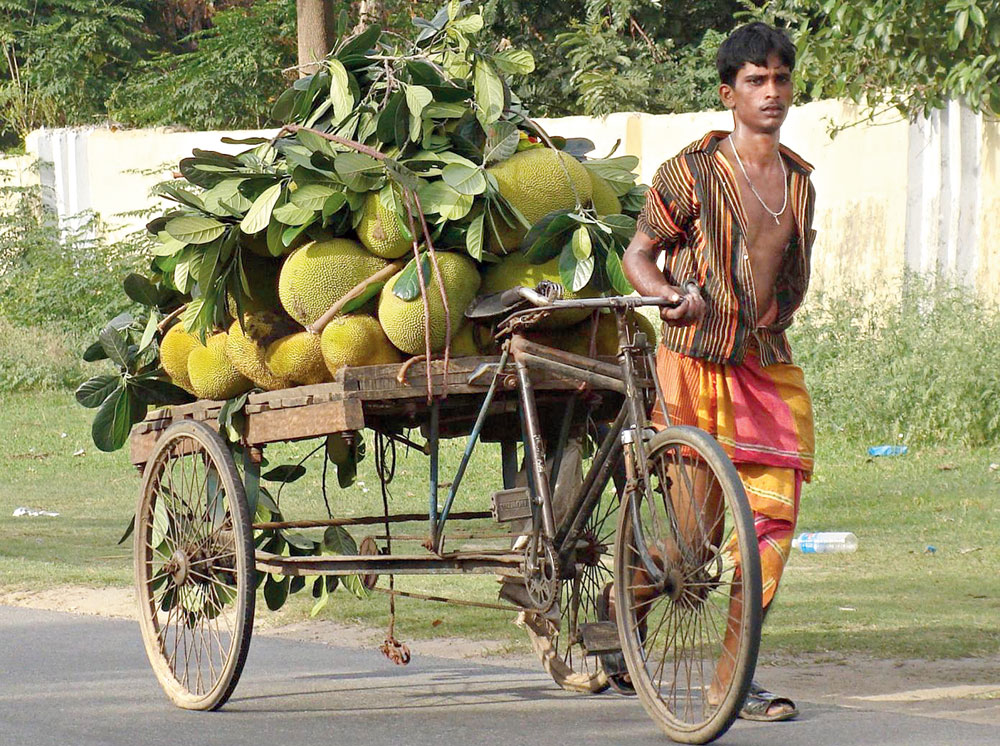Summer is the season of fruits — the majestic mango, the translucent litchi and the outsized jackfruit. Unlike the mango and litchi, which are universally liked, opinion is sharply divided on the jackfruit; people either love or hate its signature smell and golden pods. But whether you love it or hate it, there is good reason for all of us to be eternally grateful to it.
The story goes that the jackfruit is what got us toilets in Indian trains. Displayed at the National Rail Museum in New Delhi is a letter dated 1909. It is from one Okhil Chandra Sen to the Sahibganj Divisional Railway Office, then within Bengal Presidency and now in the state of Jharkhand. Wrote Okhilbabu in a language that he was conversant in but whose grammatical nuances he was yet to master: “I am arrive by passenger train at Ahmedpur station and my belly is too much swelling with jackfruit.” Indeed, too many helpings of ripe jackfruit has a tendency to upset the stomach.
Okhilbabu, in the state that he was in, had to visit the “privy”. He got off the train. But while he was doing the job, the guard blew the whistle and the train started to chug out. Okhilbabu raced, holding up both mug and dhoti, but still got left behind. To add insult to injury, he tripped, fell over and exposed “all my shockings to man and woman on platform”. No wonder he railed against the guard in his letter, demanding that a hefty fine be levied on him, failing which Okhilbabu threatened to take his grievance to the media. The next thing we know, Indian trains were fitted with toilets.
The jackfruit is native to India. According to a 2017 report of the Union ministry of agriculture and farmers welfare, Bengal produces the most jackfruit, followed by Kerala and Tripura. It gets its name from the Portugese jaca, which in turn, was derived from chakka, the Malayali name for the fruit that is called kanthal in Hindi and kaathal in Bengali. Incidentally, the Hindi kanthal is what is called enchor in Bengali, the raw version of the jackfruit. The ripe version is not popular in north India.
Fitted out in a brownish yellow prickly coat, the ripe fruit is teeming with sweet golden pods within. It has a sickly sweet smell that makes it irresistible to flies. The sap it oozes is sticky and stains easily, for which reason it is best to attack its stickiness with well-oiled hands. The jackfruit ripens in late summer and is a ritual presence at Jamai Sashthi — the festival earmarked in every Bengali household for the son-in-law — alongside mutton, mango and mishti.
There is an art — steadily disappearing — to readying the raw jackfruit for cooking. The peeler of the modern kitchen is no match for the tough, prickly skin, and a knife cannot slice through the at-least-six-inch diameter of the vegetable, especially the tough, inedible core.
“You need a sharp bonti or hansua [a standing blade fitted onto a wooden frame],” says 70-year-old homemaker Mallika Das as she expertly peels a raw jackfruit on her well-oiled bonti, squatting on the floor. “Be sure to add a tablespoon of mustard oil when you steam the vegetable in the pressure cooker,” the elder advises. “Then the latex won’t stain the aluminium.”
But most Indian kitchens today have no patience for the quirks of the jackfruit. Hassanur Rahman, the young vegetable seller with a stall at the daily market in Nagerbazar, has taken to selling peeled and chopped pieces of raw jackfruit. “I had very few takers for a whole fruit,” he says. At the bazaar, the trick is to ask for a young and tender fruit. The prickly green coat of the raw jackfruit gives you an idea about its age but with the peeled version you lose this clue.

Raw jackfruit is like a chameleon, taking on the tastes of the masalas used to cook it. Its texture imitates that of meat File photo by Pankaj Kumar Singh
“There is a very small window of time when the enchor is just right for cooking,” says food historian Pritha Sen. Too early and it will have a sharp aftertaste; too late and it begins to ripen and become stringy. “That is why it is considered a delicacy and is always in great demand,” she adds.
A great many raw jackfruits are at this perfect stage around Poila Baisakh or the Bengali New Year’s day, which is tomorrow. That is why the celebratory menu usually features an enchor dish. The simplest of dishes is the dalna, a medley of cubed jackfruit and cubed potatoes in thick rich gravy with a tempering of ghee and garam masala. While the dalna is often cooked with onions and ginger-garlic paste these days, originally it would be cooked with a flavouring of cumin and ginger.
“Onion and garlic are later imports, Bengali cuisine was originally ginger specific,” says Sen. The jackfruit dalna in the olden days would be missing the potato too — the ubiquitous alu also came in with the European colonisers. Jackfruit, however, paired well with shrimps then, and even now enchor-chingri is a constant in the home kitchen as well as at the restaurant.
Raw jackfruit is like a chameleon, taking on the tastes of the masalas used to cook it. Its texture imitates that of meat — possibly the reason it is called tree meat or gaach patha in Bengali — and it can be made to taste like meat too with a little bit of pampering. “It is said that cooked well, jackfruit curry can taste just like mutton curry, justifying the gaach patha monicker,” says Sen. In fact, before the advent of the onion and garlic, mutton too used to be cooked with only ginger and cumin in eastern India. Sacrificial mutton is still prepared that way.

There is an art to readying the raw jackfruit for cooking. The peeler of the modern kitchen is no match for the tough, prickly skin, and a knife cannot slice through the at-least-six-inch diameter of the vegetable, especially the tough, inedible core Picture by iStock
The jackfruit possibly became the gaach patha (or vegetarian mutton) around the time Vaishnavism spread in eastern India. The people of this geography were a carnivorous lot even then, loath to give up the taste of mutton though they had given up the real thing, suggests Sen. Therefore, we have the yoghurt-enhanced enchor kalia and the rich enchor korma. There is also the kofta curry and the enchor chop — both worth the long hours needed to prepare them. And now we have the jackfruit biryani too — no matter that the inventor of the world-famous rice dish must be spinning in his grave.
The popularity of the jackfruit is not limited to eastern India. Uttar Pradesh has its kanthal ka achar (raw jackfruit pickle) and the Konkan coast its phansachi bhaji (jackfruit with freshly ground masalas).
Every region has a way to extract maximum taste from this versatile vegetable. It can be deep-fried, made into curry with a range of gravies from runny to dry, turned into koftas or even cutlets. These days it is also being used to fill tacos and sandwiches because of its textural resemblance to pulled pork.
The most gastronomically fascinating aspect of it, however, are the seeds. These can be cooked into a dal, provide the crunch in mixed vegetable curries, can be thinly sliced and deep fried (delicious with dal and rice), and roasted and salted to snack on like peanuts. The taste is sweetish and nutty. Just one other way jack can taste.












